SEX OFFENDERS ON LI
SEX OFFENDERS ON LI
About SO, Reg SO, LI News, PFML/LA News, Residency Restrictions, SO Restrictions
Newsday/Denise M. Bonilla and Emily Ngo
11/26/13
Nearly 700 registered sex offenders considered moderate or high risk to repeatthe crime are concentrated in just a handful of low-income and working-class communities acrossLong Island. The problem is especially acute in Suffolk, which as of yesterday had abouttwice the number of Level 2 and 3 offenders as Nassau, there were 36,442 sex offenders on the stateregistry, a number that includes 11,617 who have been deported, are out of the state or areincarcerated. The registry publicly identifies only Level 2 and 3 offenders. Level 1offenders, which make up more than a third of the state's total number of offenders, are consideredlow risk for recidivism. Suffolk, the fourth most populous county in the state, has theeighth highest number of total offenders. More than half of Suffolk's 995 offenders, 536 areLevel 1. In addition, there are 294 Level 2 and 159 Level 3. The designations for sixare pending. Nassau has 535 in total: 299 Level 1's, 168 Level 2's, 61 Level 3's and sevenare pending.
Housing sex offenders has been a focus of debate across the United States. States and local municipalities began enacting residency restrictions in the last 1990s, not longafter the passage of the federal Megan's Law, which required sex offenders to register theiraddresses and that communities be notified of that information. By 2007, hundreds ofmunicipalities and 30 states had residency restrictions ranging from 500 feet to 1 mile fromschools, playgrounds and other areas where children congregate. However, in recent years,some of these restrictions have been overturned in court. New York State's residencyrestriction, which bans convicted offenders from living within 1,000 feet of a school or otherfacility caring for children, applies only to those on parole or probation who are Level 3, deemedthe highest risk to reoffender, or those on parole whose victims were under 18 years old. Suffolk also has a residency restriction law passed in 2006 that prohibit sex offenders from livingwithin a quarter-mile of the property lines of schools, licensed day care centers, nurseries,playgrounds, amusement parks, or the residence or place of employment of the victims of theircrime. That law is being challenged in court by Duane Moore, a Level 3 sex offender whoserved 19 years in prison for first degree rape. Nassau's residency restriction, which bannedall sex offenders from living within 1,000 feet of a school, 500 feet of a park or 2,000 feet fromthe residence or place of employment of the victims of their crime, was struck down in Nassau'sFirst District Court in 2011 as being superseded by the state law. But in September anappellate court reversed the ruling, noting that the state had no intent to prohibit localitiesfrom adopting laws concerning residency restrictions for sex offenders who are no longer onprobation or parole supervision.
Many resident fear sex offenders, believing they are highly likely toreoffend. A 2002 study by the U.S. Department of Justice found sex crime recidivism rates forsex offenders for the first three years following their release was 5.3 percent, significantlylower than recidivism rates for other types of convictions such as robbery. A study conductedby the state Department of Corrections and Community Supervision on inmates released in 2009 foundthat among sex offenders, 5 percent or less committed a new felony within three years compared with9.6 percent of all parolees who recommitted felonies. A 2007 state sex offender managementgrant study found that from 2005 to 2006, 94 percent of those charged with sexual offenses had noprior sex crime convictions.
Laura Ahearn, whose Stony Brook-based group Parents for Megan's Law is receiving$2.7 million over three years from Suffolk as part of the Community Protection Act to help monitorsex offenders, said other studies show recidivism rates climbing over longer periodspost-incarceration. Citing a national number of more than 700,000 registered sex offenders,she said, that means there's 35,000 more victims, even with a 5 percent recidivism rate. Sowe can't lose sight of what we're trying to accomplish here by focusing on sex offender recidivismrates. Ahearn acknowledges the limitations of residency restrictions. Residencyrestriction laws are not going to prevent sexual offenses from occurring, she said. However, what they can do is set out what the rules are going to be in a community. You don't wantan offender in a position where they can have daily eye-contact view of potential victims.
North Hempstead – 19 Sex Offenders
Oyster Bay – 39 Sex Offenders
Huntington – 10 Sex Offenders
Smithtown – 15 Sex Offenders
Hempstead – 156 Sex Offenders
Babylon – 51 Sex Offenders
Islip – 137 Sex Offenders
Brookhaven – 184 Sex Offenders
Riverhead – 9 Sex Offenders
Southold – 5 Sex Offenders
Shelter Island – 1 Sex Offender
Southampton – 25 Sex Offenders
East Hampton – 6 Sex Offenders
(New York)

Comments are closed.